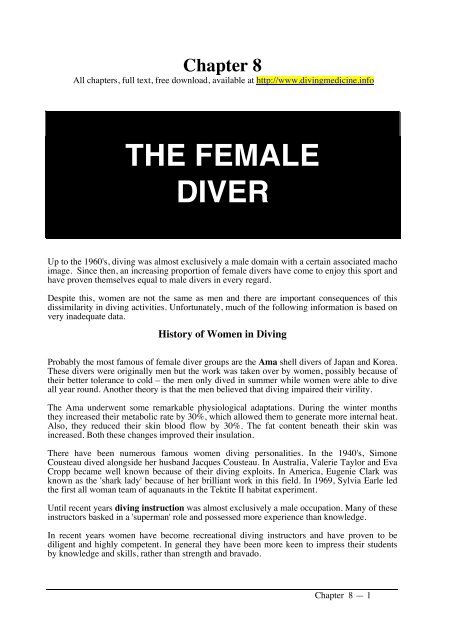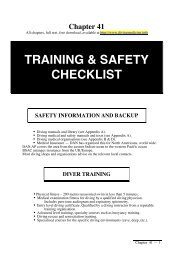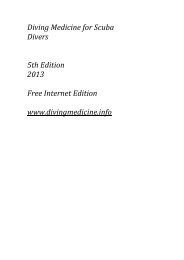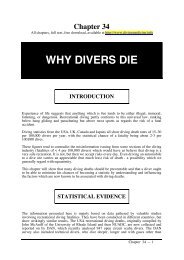Ch 08 SM12.pdf - Diving Medicine for SCUBA Divers
Ch 08 SM12.pdf - Diving Medicine for SCUBA Divers
Ch 08 SM12.pdf - Diving Medicine for SCUBA Divers
- No tags were found...
Create successful ePaper yourself
Turn your PDF publications into a flip-book with our unique Google optimized e-Paper software.
<strong>Ch</strong>apter 8<br />
All chapters, full text, free download, available at http://www.divingmedicine.info<br />
THE FEMALE<br />
DIVER<br />
Up to the 1960's, diving was almost exclusively a male domain with a certain associated macho<br />
image. Since then, an increasing proportion of female divers have come to enjoy this sport and<br />
have proven themselves equal to male divers in every regard.<br />
Despite this, women are not the same as men and there are important consequences of this<br />
dissimilarity in diving activities. Un<strong>for</strong>tunately, much of the following in<strong>for</strong>mation is based on<br />
very inadequate data.<br />
History of Women in <strong>Diving</strong><br />
Probably the most famous of female diver groups are the Ama shell divers of Japan and Korea.<br />
These divers were originally men but the work was taken over by women, possibly because of<br />
their better tolerance to cold – the men only dived in summer while women were able to dive<br />
all year round. Another theory is that the men believed that diving impaired their virility.<br />
The Ama underwent some remarkable physiological adaptations. During the winter months<br />
they increased their metabolic rate by 30%, which allowed them to generate more internal heat.<br />
Also, they reduced their skin blood flow by 30%. The fat content beneath their skin was<br />
increased. Both these changes improved their insulation.<br />
There have been numerous famous women diving personalities. In the 1940's, Simone<br />
Cousteau dived alongside her husband Jacques Cousteau. In Australia, Valerie Taylor and Eva<br />
Cropp became well known because of their diving exploits. In America, Eugenie Clark was<br />
known as the 'shark lady' because of her brilliant work in this field. In 1969, Sylvia Earle led<br />
the first all woman team of aquanauts in the Tektite II habitat experiment.<br />
Until recent years diving instruction was almost exclusively a male occupation. Many of these<br />
instructors basked in a 'superman' role and possessed more experience than knowledge.<br />
In recent years women have become recreational diving instructors and have proven to be<br />
diligent and highly competent. In general they have been more keen to impress their students<br />
by knowledge and skills, rather than strength and bravado.<br />
<strong>Ch</strong>apter 8 — 1
Women divers must be doing something right. <strong>Diving</strong> statistics show that females comprise<br />
34% of trainees, but account <strong>for</strong> only 10-20% of fatalities (depending on the survey).<br />
Scuba Training<br />
In Western society, women are generally regarded as being less mechanically and<br />
mathematically adept than men. This prejudice is reflected in attitudes to diver training. In<br />
many cases, women are patronised by well-meaning male instructors and male companions.<br />
Until recently, culturally acquired lack of assertiveness on the part of many women led them to<br />
refrain from asking what appeared to them to be naive questions of their instructors. On the<br />
other hand, prejudices by instructors led them to assume women would not be interested in, or<br />
understand, the intricacies of equipment functioning or decompression planning. This<br />
in<strong>for</strong>mation tended to be directed towards the males in a training group. Women would often<br />
turn to a male friend or buddy rather than the instructor <strong>for</strong> answers to questions which arose<br />
during training. The in<strong>for</strong>mation that they received was not always accurate.<br />
A woman who has her<br />
equipment assembled and<br />
checked by a male companion,<br />
who has the equipment carried to<br />
the water and who is assisted<br />
into and out of the water, is<br />
overall less likely to become a<br />
competent and self sufficient<br />
diver.<br />
The old stereotype of the woman<br />
in a dependent role can lead to<br />
problems in diving practice.<br />
Thus having men and women<br />
buddied together <strong>for</strong> basic<br />
training may be inappropriate.<br />
The concept, introduced by<br />
PADI some years ago, of an allwomen<br />
class has much to<br />
commend it.<br />
Fig. 8.1<br />
Anatomical Differences<br />
Womankind has been described as the "weaker sex." While it is generally true that on average<br />
women are less physically strong than men, there is not a vast difference in their per<strong>for</strong>mance<br />
in aquatic sports. For example, in the 1988 Olympics there was only a 10–12% difference in<br />
times between women and men <strong>for</strong> swimming events.<br />
For the same physical size, men on average have greater physical strength than women. This is<br />
because men have a greater muscle mass per unit body weight. This minor difference in<br />
strength is much less significant in the weightless aquatic environment.<br />
<strong>Ch</strong>apter 8 — 2
Being physically smaller, the woman has a lower requirement <strong>for</strong> oxygen at a given level of<br />
physical activity and will produce less carbon dioxide. With smaller lungs, women also take<br />
smaller breaths. Thus, women can often manage with less air than a male diving companion<br />
and so can use a smaller, lighter scuba cylinder. This can offset the apparent disadvantage of<br />
diminished body size and strength.<br />
Because of differences in body shape, women have different equipment design requirements.<br />
There can be difficulty in obtaining appropriate sized or shaped wet suits, fins, boots, and<br />
gloves, in less developed countries.<br />
Particular problems arise with male sized equipment, especially face masks which may not fit<br />
well, and large scuba cylinders which are unnecessarily bulky or heavy. Backpacks can be too<br />
long and so cover the weight belt, making the release of the belt in an emergency difficult.<br />
Over sized buoyancy compensators designed <strong>for</strong> males may give excessive buoyancy and drag<br />
with females.<br />
<strong>Diving</strong> Activity<br />
It is anecdotally believed that males tend to dive deeper, longer, more frequently and engage in<br />
more rapid ascents. Whether this is true, is unknown, but they certainly do engage in more risktaking<br />
activities than females in all general epidemiological surveys, and so perhaps it is<br />
correct. They also suffer many more accidents and traumatic deaths than females – at all ages.<br />
In one study, females dived mostly between 19-40m (61-68% of the activity) and much less<br />
between 41-60m (16-26%) or greater than 60m (1-2%). Young females dived at a more varied<br />
depth but also deeper than older females.<br />
Thermal Variations<br />
Women are better insulated than their male counterparts. They have a fat layer beneath the skin<br />
some 25% greater then men. They also have a better ability to constrict the blood flow to their<br />
limbs, reducing heat loss. These factors allow women to conserve their heat more effectively in<br />
a cold water environment while producing natural buoyancy, which improves their swimming<br />
and floating ability.<br />
Un<strong>for</strong>tunately women tend to expose themselves less to demanding environmental<br />
temperatures, and so may not become as well adapted to cold exposure, and initially react more<br />
to this situation.<br />
Menstruation<br />
Some women perceive their ability to dive safely during the menstrual cycle may be impaired,<br />
and that the activity of scuba diving may alter the menstrual cycle. Statistically there is some<br />
justification <strong>for</strong> believing that diving related incidents are more frequent around the time of<br />
menstruation.<br />
During menstruation, the average woman is likely to lose 50–150cc blood and cellular debris.<br />
There are some physical and physiological consequences of menstruation which will be<br />
discussed, but usually there is no reason why women should not dive during menstruation. For<br />
<strong>Ch</strong>apter 8 — 3
convenience, most women today prefer to wear internal protection such as tampons rather then<br />
menstrual pads. In the early days, there was some concern that menstrual blood-loss may act as<br />
an attractant to sharks. In fact, females have a much lower incidence of shark attacks than<br />
males. This may be related to their different diving behaviour, or that haemolysed blood is a<br />
shark repellant.<br />
Menstrual pads and protection<br />
There is little reason to avoid diving during the menstrual period. If the<br />
woman develops significant psychological problems at this time, then of<br />
course this must be considered on its merits, but this is not common.<br />
The main difficulty with menstruation during diving or swimming is the<br />
physical and social complication of a bloody discharge, and the attempts<br />
to limit its distribution and appearance.<br />
Menstrual pads can cause problems. A pad, especially some of the older<br />
styles, can leak, disintegrate and move (more so in a dry suit). They are<br />
also too obvious in a Bikini style bathing costume. Infinity pads may be<br />
acceptable in a dry suit.<br />
Tampons are effective and cause few or no problems. The Diva cup,<br />
Mooncup or the disposable Instead cup are effective and convenient.<br />
Hormonal changes be<strong>for</strong>e and during menstruation tend to cause fluid retention and swelling.<br />
There is a theoretical possibility that this might encourage the development of DCS, and one<br />
study of altitude DCS suggested that DCS was more likely earlier in the menstrual cycle. This<br />
has not been validated <strong>for</strong> divers. There is minimal experimental data to support this<br />
association, but it may be wise <strong>for</strong> women, at least during this time, to add a safety margin to<br />
their decompression requirements.<br />
Some women have significant psychological and physical problems around the time of<br />
menstruation, with abdominal pain, muscle cramps, headaches, nausea and vomiting. These<br />
may impair their diving ability. Women who suffer from severe problems of this nature, are<br />
advised to avoid diving at this time. The psychological disturbances associated with premenstrual<br />
tension and anxiety, may sometimes warrant the avoidance of diving during this<br />
time.<br />
Some female migraine sufferers, have an increased likelihood of migraines around the time of<br />
menstruation. The problems associated with migraine are discussed further in <strong>Ch</strong>apter 32 and<br />
the recommendations there should be followed.<br />
Repeated exposure to high pressure environments seems to have no significant effect on<br />
hormone regulation, ovulation or menstruation.<br />
<strong>Ch</strong>apter 8 — 4
Oral Contraceptives<br />
(the "Pill")<br />
The physiological and psychological consequences of these hormonal tablets may have similar<br />
implications to those described above, under "menstruation". In theory, the increased<br />
coagulation effects from the pill could initiate or aggravate DCS. In practice this has not been<br />
observed. There is no relationship between the development of DCS and the taking of oral<br />
contraceptive tablets per se. It was considered prudent to cease oral contraceptives in the<br />
female team who undertook a long saturation dive during the Tektite No. 2 project. However,<br />
the absence of males probably made this decision an uncomplicated one.<br />
Decompression Sickness (DCS)<br />
Several studies have shown an increased incidence of DCS in women. Some studies of women<br />
divers showed a more than 3 times increased incidence of DCS compared with men who were<br />
exposed to the same dive profiles. Other studies have not shown this and perhaps the different<br />
observations are due to different cohorts with different dive profiles. For example, females in<br />
the space program seemed to be more susceptible to altitude DCS, and develop more serious<br />
DCS, than men.<br />
Studies on female divers indicated that those who did “reverse profile” dives had more DCS<br />
symptoms than those who did their deeper dives first. In a large series of DCS cases it was<br />
shown that the men so affected dived deeper than the women (almost 3 metres) and it is<br />
possible that their diving exposures and ascent rates were greater.<br />
The weight of evidence does tend to suggest that there might be an increased incidence of DCS<br />
among women. There are several possible explanations <strong>for</strong> this.<br />
Women are frequently less physically fit than men and physical fitness is negatively related to<br />
DCS. Women usually have a higher proportion of subcutaneous body fat (+ 10%) <strong>for</strong> a given<br />
weight than men, and the body fat has a 4-5 times higher capacity <strong>for</strong> absorbing nitrogen. Fat<br />
tissue is slower to absorb and to eliminate the nitrogen. Logically, because of the different fat<br />
distribution between the sexes, studies that dealt with certain dive profiles (longer dives) could<br />
have more nitrogen absorbed and a greater incidence of DCS in females. Both reduced physical<br />
fitness and higher fat content probably increase the incidence of DCS .<br />
Navy decompression tables were designed <strong>for</strong> and tested on physically fit, healthy young male<br />
divers. Strictly speaking, the tables should only apply to this population.<br />
Because of this increased risk, it is wise <strong>for</strong> women divers to apply extra safety factors when<br />
using the dive tables: e.g. by reducing the allowable bottom time <strong>for</strong> any depth or by<br />
decompressing <strong>for</strong> a greater duration. Decompression computer programs should be on the<br />
more conservative settings.<br />
A modern decompression problem has emerged with breast implants. Fortunately, gas filled<br />
implants are no longer used, as the barotrauma consequences of diving with these would be<br />
disturbing. However, even silicone filled implants do absorb nitrogen during a dive and a 4%<br />
expansion in the size of these implants has been recorded after dive profiles commonly used by<br />
women sports divers. This is not likely to cause a problem with the implants. However, if these<br />
women were involved in saturation diving there is the potential <strong>for</strong> significant volume changes<br />
which could lead to damage or rupture of the implant during or after ascent.<br />
<strong>Ch</strong>apter 8 — 5
Other <strong>Diving</strong> Diseases<br />
In a number of reports on scuba divers pulmonary oedema, a preponderance of females has<br />
been noted. Others have suggested an increased susceptibility to dysbaric osteonecrosis.<br />
The relative risk of oxygen toxicity <strong>for</strong> women compared to men was 1.6 times <strong>for</strong> pulmonary<br />
toxicity and 2.9 times <strong>for</strong> neurological toxicity.<br />
Panic is a common and potentially serious problem even amongst experienced divers. Although<br />
females reported this more frequently than males, the latter waited longer to react and so it was<br />
more likely to progress to a life threatening situation in them.<br />
A study of dive masters and instructors found that female instructors and dive masters reported<br />
more diving-related ear and sinus symptoms than males. This relation was consistent even<br />
when controlling <strong>for</strong> potential confounders.<br />
PREGNANCY<br />
There has been considerable controversy over whether pregnant women should dive. This<br />
question arises because most women divers are in the child-bearing age group. The controversy<br />
hinges on the conflict between restricting the freedom of an individual and the risks (which<br />
have not been fully evaluated) to the unborn child. The potential problems of diving during<br />
pregnancy are as follows:<br />
! Vomiting.<br />
Maternal Effects<br />
In the second and third months of pregnancy, many women are prone to vomiting – often<br />
manifest as "morning sickness". They are more prone to seasickness and to nausea and<br />
vomiting underwater during certain conditions. This predisposes to serious diving accidents.<br />
! Barotrauma.<br />
From the fourth month onwards, fluid retention and swelling of the lining of the respiratory<br />
tract, makes sinus and ear equalisation more difficult and predisposes to barotrauma.<br />
! Respiratory function.<br />
There is a decline in respiratory function as pregnancy progresses. There is an increase in<br />
resistance to air flow in the lungs. Later, the enlarging baby presses up into the chest, limiting<br />
breathing capacity. This combination impairs the pregnant woman's ability to cope with<br />
strenuous activity which may be required in an emergency, and may predispose to hypoxia or<br />
pulmonary barotrauma.<br />
! Decompression sickness.<br />
There are major alterations in blood volume and circulation during pregnancy. This may<br />
increase the uptake and distribution of nitrogen and may make the woman more prone to DCS.<br />
<strong>Ch</strong>apter 8 — 6
! Infection.<br />
It has been claimed that there is an increased risk of vaginal infection in pregnant women who<br />
dive. In the later stages of pregnancy some women develop minor leaks of the amniotic sac,<br />
which surrounds the baby with fluid. There is a possibility of infection of this fluid from<br />
organisms entering from the water be<strong>for</strong>e birth or directly into the womb after birth.<br />
Effects on the Baby<br />
The developing foetus is uniquely at risk from some of the physiological hazards associated<br />
with diving. The potential risk primarily consists of DCS, but hyperoxia, hypoxia, hypercapnia<br />
and increased nitrogen pressure may also be involved.<br />
! Development of the foetus.<br />
The foetus begins as a single cell organism and up until after the fourth month it is smaller than<br />
a mouse. A small bubble, such as develops during DCS, could have catastrophic effects.<br />
The circulation in the foetus is unique and critical. In an adult diver, venous blood returning<br />
from the body passes through the lung capillaries, which filter out the bubbles frequently<br />
<strong>for</strong>med during or after ascent. In the foetus, the blood by-passes the lungs (since the foetus<br />
does not need to breathe) and passes directly to the left heart without passing first through this<br />
filtering network. Even one bubble <strong>for</strong>ming in the tissues then veins of a foetus will be<br />
transported directly to the arterial circulation and will embolise to somewhere in its body.<br />
In one study it was shown that diving >30 metres in the first trimester was associated with a<br />
16% risk of foetal abnormality, but the numbers were small. Other studies have produced<br />
conflicting data.<br />
! Hypoxia.<br />
The outcome of many non-fatal diving incidents is hypoxia, most likely to be caused by salt<br />
water aspiration or near drowning. The pregnant diver will not only expose herself to hypoxia<br />
in this situation but will also expose the much more susceptible foetus to this.<br />
! Hyperbaric oxygen.<br />
<strong>Divers</strong> are likely to be exposed to hyperbaric oxygen in two situations. By simply breathing<br />
compressed air at depth they are inhaling elevated partial pressures of oxygen. In addition, if<br />
divers develop DCS or air embolism they will be given hyperbaric oxygen therapy <strong>for</strong><br />
treatment of the condition.<br />
Some foetal tissues are very sensitive to high partial pressures of oxygen. Great care is taken<br />
with newborn premature babies to avoid administration of high concentrations of oxygen<br />
because of the danger of retrolental fibroplasia, which causes blindness. The eye of the unborn<br />
baby is probably even more sensitive to high partial pressures of oxygen.<br />
The circulation of the foetus contains a channel (the ductus arteriosus) which allows blood to<br />
by-pass the lungs. This channel closes after birth under the influence of a raised partial pressure<br />
of oxygen in the blood. There is a danger of premature closing of this and other shunts if the<br />
foetus is exposed to hyperbaric oxygen because of treatment given to the mother.<br />
<strong>Ch</strong>apter 8 — 7
! Decompression sickness.<br />
As mentioned earlier, women may have increased susceptibility to DCS and there are<br />
theoretical reasons to believe that pregnant women are even more susceptible. It is known from<br />
Doppler studies that showers of bubbles are regularly <strong>for</strong>med in the veins of divers ascending<br />
from many routine non-decompression dives. These bubbles do not usually cause any<br />
symptoms.<br />
Some experiments in pregnant animals suggest that the foetus is more resistant to bubble<br />
<strong>for</strong>mation than the mother but that bubbles do <strong>for</strong>m after some dives, especially those deeper<br />
than 20 metres. Because of the unique circulation of the foetus even a few bubbles in the foetal<br />
circulation can have disastrous consequences.<br />
Experiments with pregnant animals have produced conflicting results. One study on pregnant<br />
sheep (which have a placenta similar to a human) showed that the foetus developed bubbles in<br />
its circulation even after dives of less than 30 metres (100 ft.) and within the US Navy nodecompression<br />
limits. These results are disturbing when considering the vulnerability of the<br />
foetus to any bubble.<br />
Other studies have shown an increased incidence of abortion, birth defects and still-births in<br />
pregnant animals after decompression.<br />
Exposure to hyperbaric oxygen has also been shown in some studies to cause birth<br />
abnormalities and death.<br />
Human Data<br />
Japanese female divers, the Ama, often dived until late pregnancy, and had a 44% incidence of<br />
premature delivery with a high incidence of small babies when compared with non-diving<br />
women from the same area. Another survey on modern day Ama, who were not exposed to the<br />
same stresses, did not reflect this association.<br />
Margaret Bolton from the University of Florida carried out a survey on 2<strong>08</strong> women who dived<br />
during pregnancy. She found an increased incidence of abortion, still-birth, low birth weight<br />
and death of the infant within the first month. Of the 24 women who reported diving to 30<br />
metres (100 ft) or more, three had children with congenital defects. This contrasts with an<br />
incidence of 1 in 50 in the general population. One of the infants had an absent hand, a very<br />
rare abnormality.<br />
An Australian case report, showing multiple grotesque abnormalities after diving, suggested<br />
that the effects and vulnerable time frame may be similar to taking congenital-abnormality<br />
producing drug, Thalidomide, during pregnancy.<br />
It is difficult to draw firm conclusions from these studies, or others that have been conducted,<br />
because the numbers are too low <strong>for</strong> statistical validation, or are retrospective. They are<br />
however consistent with many of the animal studies.<br />
The Bottom Line ---<br />
There is considerable evidence suggesting that diving during pregnancy is harmful to the<br />
foetus. It is generally accepted that unnecessary drugs, alcohol and smoking should be avoided<br />
during pregnancy because of the risk to the foetus and we recommend a similar conservative<br />
<strong>Ch</strong>apter 8 — 8
approach to diving. The sacrifice of not diving during pregnancy may be easier to cope with<br />
than the guilt, valid or not, associated with abortion or giving birth to a mal<strong>for</strong>med child.<br />
Evidence in western societies suggest that female divers have accepted the above restriction<br />
and now do avoid diving when pregnant, or when attempting to become pregnant, making the<br />
collection of more data difficult, but good <strong>for</strong> the kids.<br />
One interesting issue to consider by women who contemplate diving during pregnancy is that<br />
the foetus, who will have to live with any birth defect which may result, cannot be consulted<br />
when the decision to dive is made.<br />
Fig. 8.2<br />
<strong>Ch</strong>apter 8 — 9











